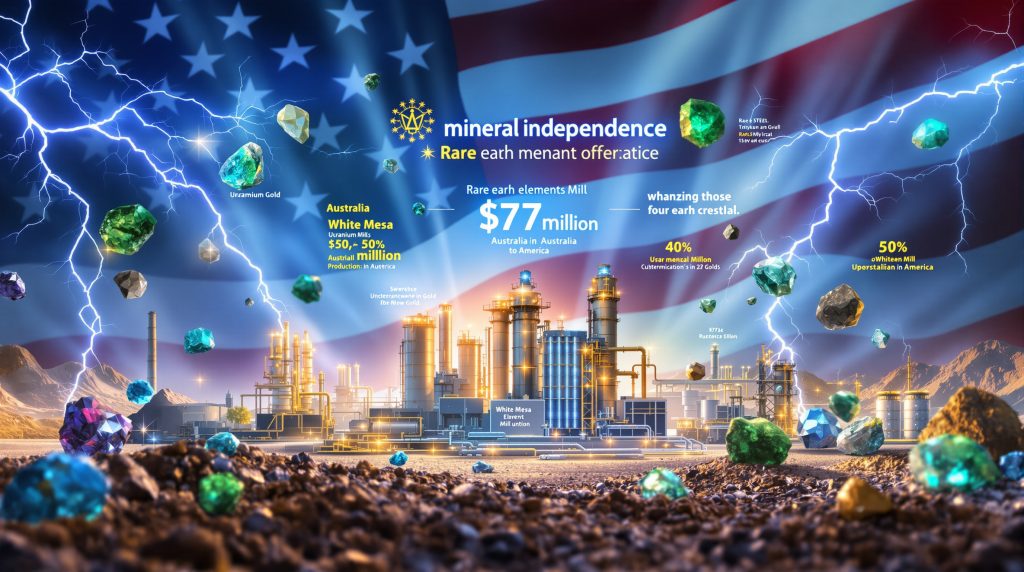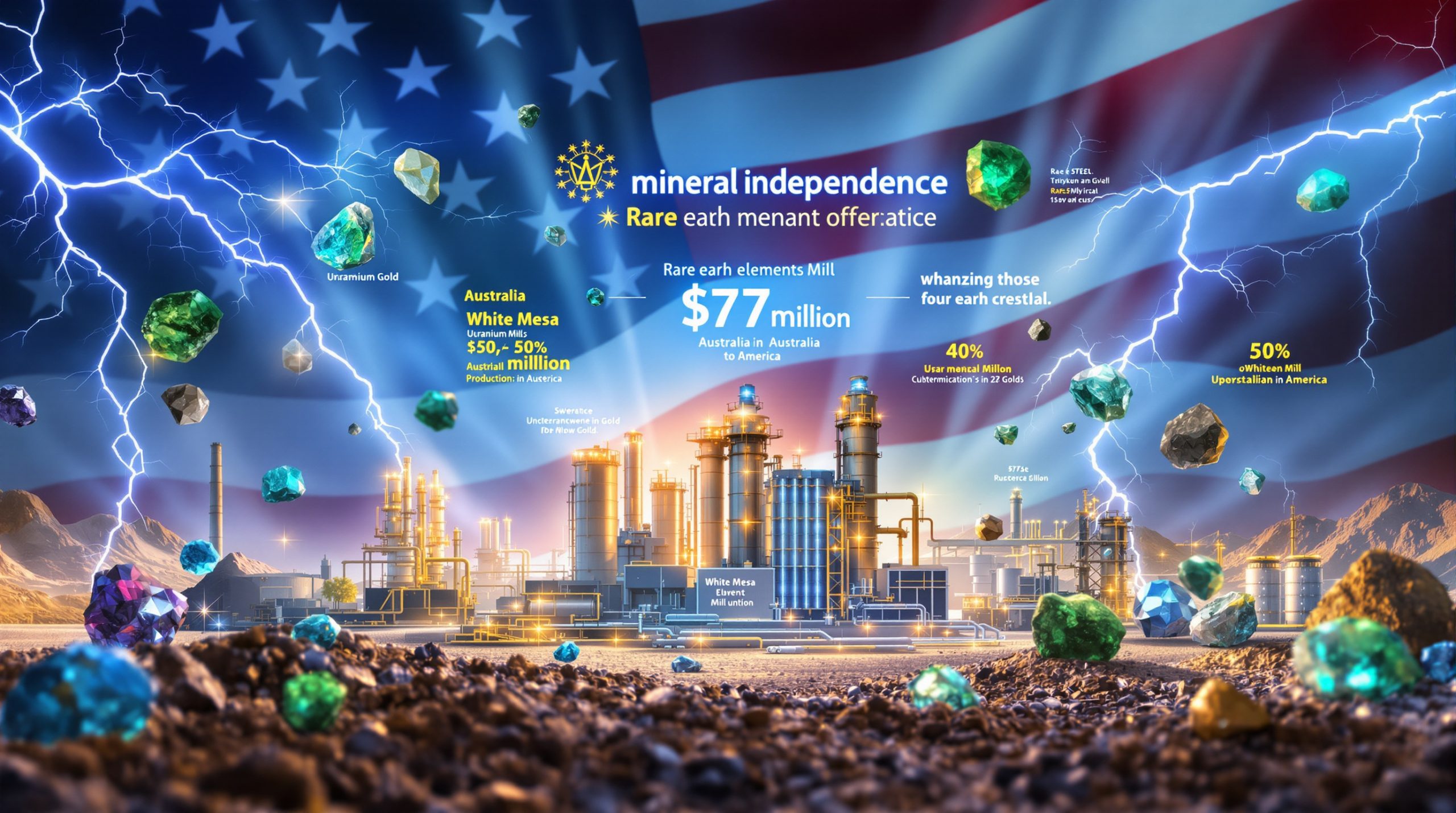America's Critical Mineral Independence: Inside the $700 Million Investment Reshaping U.S. Supply Chains
What Is Driving America's Push for Mineral Independence?
The United States faces a critical vulnerability in its supply chains for essential minerals and rare earth elements. With China controlling approximately 70% of global rare earth production and nearly 90% of processing capacity, American industries from defense to clean energy confront significant security risks. This dependency has sparked urgent efforts to develop domestic capabilities across the entire critical minerals value chain.
Recent geopolitical tensions have only intensified this push, with both government initiatives and private sector investments accelerating to establish resilient, non-Chinese supply alternatives. The stakes couldn't be higher – these materials form the backbone of technologies essential to critical minerals & energy security and economic competitiveness.
How Energy Fuels Secured a $700 Million Vote of Confidence
In a landmark development for America's mineral independence strategy, Energy Fuels recently closed a $700 million convertible bond offering that signals extraordinary institutional confidence in domestic processing capabilities. The financing was completed in just one week with Goldman Sachs as sole bookrunner and was oversubscribed six to seven times, demonstrating remarkable market enthusiasm.
The convertible structure includes strategic features designed to minimize shareholder dilution:
- Conversion price set at approximately $15.35
- Purchase of capped call options with a strike price of $30.70 per share
- Exceptionally favorable 0.75% interest rate
This overwhelming response from institutional investors validates Energy Fuels' strategic approach to addressing critical gaps in America's mineral supply chains. The capital allocation focuses primarily on two strategic initiatives:
- Funding Phase 2 expansion at the White Mesa Mill to build processing capacity comparable to Lynas Corporation's operations
- Advancing the Donald project in Australia, a joint venture with Astron that would secure international supply of critical materials
Table: Key Features of the $700 Million Convertible Bond
| Feature | Details |
|---|---|
| Interest Rate | 0.75% |
| Oversubscription | 6-7 times |
| Conversion Price | $15.35 |
| Capped Call Strike | $30.70 |
| Lead Bookrunner | Goldman Sachs |
| Primary Allocations | White Mesa Phase 2, Donald Project |
Why White Mesa Mill Represents America's Critical Mineral Hub
At the heart of Energy Fuels' strategy sits the White Mesa Mill in Utah – the only conventional uranium mill in the United States with existing permits and infrastructure to process radioactive monazite ore. This unique facility provides operational flexibility that distinguishes Energy Fuels from development-stage competitors:
- Capability to process approximately 240,000 pounds of recovered uranium monthly
- Ability to switch between uranium and rare earth processing depending on uranium market volatility
- Existing rare earth separation circuit with plans to add separation capability for heavy rare earths
- Regulatory approvals for handling radioactive materials that create significant barriers to entry for competitors
The mill's strategic importance cannot be overstated – it represents operational infrastructure that would require competitors years and hundreds of millions of dollars to replicate. This established processing capability positions Energy Fuels to address immediate supply chain vulnerabilities while other projects remain in planning stages.
How Monazite Processing Addresses Critical Supply Chain Gaps
Energy Fuels' strategic focus on monazite processing represents a deliberate differentiation from other rare earth development efforts. Unlike bastnaesite ore (processed by MP Materials), monazite contains both uranium and the full spectrum of rare earth elements – including critical heavy rare earths like dysprosium and terbium that command significant price premiums.
The company's ability to process radioactive monazite provides unique access to:
- Neodymium and praseodymium (NdPr) – essential for permanent magnets in electric vehicles and wind turbines
- Dysprosium and terbium (DyTb) – critical heavy rare earths necessary for high-temperature performance in magnets
- Samarium – used in specialized magnet applications and defense technologies
This focus on monazite addresses a fundamental gap in North American supply chains. The radioactive components in monazite have historically deterred processors, but Energy Fuels' existing infrastructure and regulatory approvals eliminate this barrier, creating a significant competitive advantage.
Market Context: Heavy rare earths from non-Chinese sources currently command price premiums three to four times higher than Chinese alternatives, reflecting acute supply concerns and manufacturers' willingness to pay substantially more for supply chain security.
When Will Uranium Operations Generate Cash to Fund Expansion?
Energy Fuels' uranium business forms the foundation of its broader critical minerals strategy. As the largest uranium producer in the United States, the company is ramping toward two million pounds of annual production from 100% owned projects. Critically, these operations have reached a turning point and are now cash flow positive.
The uranium production profile draws from multiple mines including:
- Pinyon Plain (processing began August 2025)
- Pandora
- La Sal
- Potential to restart additional underground mines
- Ongoing drilling at Nichols Ranch in Wyoming
This self-sustaining uranium business provides a significant advantage over development-stage companies that must continuously access capital markets. Energy Fuels' uranium revenue is projected to generate sufficient cash to fund all general and administrative expenses across the company while supporting rare earth and heavy mineral sands development.
The low-cost structure derives from processing stockpiled ore and alternate feed materials that have already been mined, reducing the capital intensity compared to conventional mining operations and positioning Energy Fuels as one of the lowest-cost uranium producers in the United States.
What Makes the Donald Project a Strategic International Asset?
The Donald rare earths project in Australia represents a near-term development opportunity with exceptional characteristics that complement Energy Fuels' domestic processing capabilities. The company is earning a 49% ownership stake while securing 100% of the monazite through a transfer pricing mechanism.
Key attributes of the Donald project include:
- Fully permitted and shovel-ready status
- Completed feasibility work
- Capital costs estimated around $300 million
- Exceptionally high grades of heavy rare earths
- Phase 1 production of approximately 7,000 tons per year of monazite
The Australian location offers several strategic advantages including political stability, established mining infrastructure, and alignment with allied nation supply chains. The project can move into construction quickly pending final investment decision, with the $700 million convertible offering providing significant financial flexibility to advance development.
How Is Energy Fuels Building Downstream Integration?
Beyond mining and processing, Energy Fuels is actively developing downstream integration toward metals, alloys, and magnets – the higher-value segments of the rare earth supply chain. The company has engaged former automotive industry executives to assist with magnet development and formed strategic partnerships to advance manufacturing capabilities.
Progress in downstream integration includes:
- Partnership with POSCO advancing to producing sintered magnet blocks
- Engagement of Debra Bennethum (former General Motors) to assist with metal, alloy, and magnet development
- Focus on producing magnets for electric vehicle motors and other applications
This vertical integration strategy addresses a critical weakness in Western supply chains – the lack of manufacturing capacity for rare earth metals and magnets outside of China. By developing capabilities across the entire value chain, Energy Fuels aims to provide a complete non-Chinese alternative for manufacturers seeking supply security.
What Timeline Can Investors Expect for Production Scaling?
Energy Fuels has demonstrated a five-year track record of building rare earth infrastructure while simultaneously growing uranium production. This execution capability distinguishes the company from competitors making aspirational claims without operational progress.
Near-term milestones investors should monitor include:
- Completion of feasibility studies on Toliara, Donald, and White Mesa Phase 2 (expected by year-end 2025)
- Final investment decision on the Donald project
- Permitting approvals from Utah for the Phase 2 White Mesa expansion
- Quarterly uranium production figures demonstrating the ramp toward two million pounds annually
- Announcements regarding offtake agreements for rare earth production
- Progress updates on downstream partnerships and magnet manufacturing
While specific production timelines depend on final investment decisions and construction schedules, Energy Fuels' combination of existing infrastructure, completed feasibility work, secured permits, and available capital positions the company to potentially scale rare earth production within a 2-3 year timeframe – significantly faster than the 5-10 year horizons typical of greenfield development projects.
How Does This Investment Fit Into America's Broader Mineral Strategy?
Energy Fuels' $700 million capital raise exemplifies a major private-sector commitment to advancing America's critical mineral independence. This investment aligns with broader government initiatives, including Trump's critical minerals order, to secure supply chains for materials essential to defense, clean energy, and advanced manufacturing.
The company's approach directly addresses several priorities in America's mineral strategy:
- Developing domestic processing capacity for rare earths and uranium
- Securing supply chains for heavy rare earths currently dominated by China
- Building partnerships with allied nations (Australia) to diversify supply sources
- Advancing downstream manufacturing capabilities for high-value products
- Creating infrastructure that can process multiple critical minerals through shared facilities
What distinguishes Energy Fuels in discussions around reshoring critical mineral supply chains is its existing operational infrastructure. While many companies and government programs remain in planning stages, White Mesa Mill represents actual processing capacity that is constructed, permitted, and operating today.
What Investment Opportunities Does This Create in the Critical Minerals Sector?
For investors seeking exposure to critical minerals and America's push for supply chain security, Energy Fuels offers several compelling attributes:
-
Operational cash flow: Unlike development-stage companies, Energy Fuels generates revenue from uranium production today, providing financial stability and reducing reliance on capital markets.
-
Strategic diversification: The company's portfolio spans uranium, rare earths, and heavy mineral sands, providing exposure to multiple critical mineral markets through a single investment.
-
Existing infrastructure: The White Mesa Mill represents a significant competitive advantage through permits, regulatory approvals, and operational capabilities that would take competitors years to replicate.
-
Heavy rare earth access: Energy Fuels' focus on monazite provides exposure to dysprosium and terbium – heavy rare earths that command significant price premiums and face acute supply constraints.
-
Vertical integration potential: The company's downstream initiatives toward metals, alloys, and magnets offer exposure to higher-margin segments of the rare earth value chain.
The recent $700 million convertible offering at exceptionally favorable terms indicates sophisticated institutional investors recognize significant value in this strategic positioning. For those looking to participate in America's critical mineral independence, Energy Fuels represents an operational platform rather than a speculative development story.
What Challenges Remain for America's Mineral Independence?
Despite significant investments like Energy Fuels' $700 million capital raise, America faces substantial challenges in achieving true mineral independence:
-
Scale disparities: China's decades-long investment in rare earth processing and manufacturing has created capacity advantages that will take years to match.
-
Technical expertise gaps: The specialized knowledge required for rare earth separation and processing remains concentrated in a small number of companies globally.
-
Economic competitiveness: Chinese producers benefit from lower environmental standards, government subsidies, and established economies of scale that create cost advantages.
-
Downstream manufacturing: Processing capacity represents only one component of the supply chain – developing magnet manufacturing and other downstream capabilities requires additional investment and expertise.
-
Geological constraints: The uneven global distribution of critical mineral deposits means some level of international trade and cooperation will remain necessary regardless of domestic development.
Addressing these challenges requires sustained investment across multiple companies and government support for infrastructure development. Energy Fuels' focus on monazite processing represents one critical piece of a much larger puzzle in building resilient supply chains.
Conclusion: The Strategic Implications of America's $700 Million Mineral Bet
The $700 million investment in Energy Fuels' critical mineral strategy represents far more than a single company's growth plan – it signals a fundamental shift in how America approaches supply chain security for materials essential to modern technology and national defense.
This capital commitment demonstrates that institutional investors recognize both the strategic necessity and economic opportunity in developing domestic processing capabilities. The overwhelming market response to the convertible offering suggests sophisticated financial institutions see significant value in Energy Fuels' approach to addressing critical supply gaps.
For America's mineral independence, this investment provides tangible progress toward reducing dependence on Chinese rare earth supplies. While complete self-sufficiency remains challenging due to geological realities, Energy Fuels' focus on monazite processing addresses specific vulnerabilities in heavy rare earth supply chains where Chinese dominance has been most pronounced.
The coming years will determine whether this $700 million bet marks the beginning of a broader transformation in global critical mineral supply chains or remains an isolated example of private sector initiative. What's clear is that the strategic imperative for secure, non-Chinese supply alternatives has never been stronger, and Energy Fuels' unique positioning at the intersection of uranium and rare earth processing provides a foundation for America's mineral independence strategy.
FAQ: Understanding America's Critical Mineral Independence Strategy
What makes rare earth elements "critical" to national security?
Rare earth elements are essential components in advanced weapon systems, including precision-guided munitions, radar systems, night vision equipment, and communications technology. Heavy rare earths like dysprosium and terbium are particularly critical for applications requiring high-temperature performance. China's dominance in processing these materials creates strategic vulnerabilities that directly impact defense capabilities and technological sovereignty.
How does Energy Fuels' approach differ from other rare earth companies?
Unlike companies focused on light rare earths from bastnaesite deposits, Energy Fuels processes monazite ore containing both light and heavy rare earths plus uranium. This provides access to the full spectrum of rare earth elements, including critical heavy rare earths that command significant price premiums. Additionally, Energy Fuels operates existing processing infrastructure at White Mesa Mill rather than proposing theoretical development projects, allowing for near-term production capabilities rather than extended development timelines.
What role does the government play in America's mineral independence?
The U.S. government has implemented multiple initiatives to support critical mineral development, including funding for research and development, tax incentives for domestic production, and restrictions on certain foreign imports. However, Energy Fuels' $700 million private market financing demonstrates that commercial viability exists independent of government support. The company's strategy focuses on building economically sustainable operations rather than relying on ongoing government subsidies or programs.
How long will it take America to achieve mineral independence?
Complete mineral independence remains challenging due to geological realities and the global distribution of critical mineral deposits. However, targeted independence in processing capacity and downstream manufacturing could be achieved within 5-10 years with sustained investment. Energy Fuels' timeline for scaling rare earth production represents one of the most accelerated paths in the industry, with potential production growth within 2-3 years leveraging existing infrastructure rather than greenfield development.
How do rare earth prices outside China compare to Chinese alternatives?
Heavy rare earths from non-Chinese sources currently command price premiums three to four times higher than Chinese alternatives, while neodymium-praseodymium has surged from $55 to approaching $90 per kilogram. These price differentials reflect both supply constraints and manufacturers' willingness to pay substantial premiums for supply chain security and diversification away from Chinese sources, creating economic incentives for companies developing non-Chinese supply alternatives.
Further Exploration:
Readers interested in learning more about America's critical mineral independence strategies can also explore related educational content from the Crux Investor website, which offers analysis on developments in the critical minerals sector. Furthermore, those interested in the potential impact of tariff policies should examine recent developments in the US uranium market disruption and U.S. uranium investment trends.
Seeking Early Insight Into the Next Major Mineral Discovery?
Discovery Alert's proprietary Discovery IQ model delivers real-time notifications on significant ASX mineral discoveries, helping investors capitalise on opportunities before the broader market. Visit our discoveries page to understand how major mineral discoveries have historically generated substantial returns for early investors.




